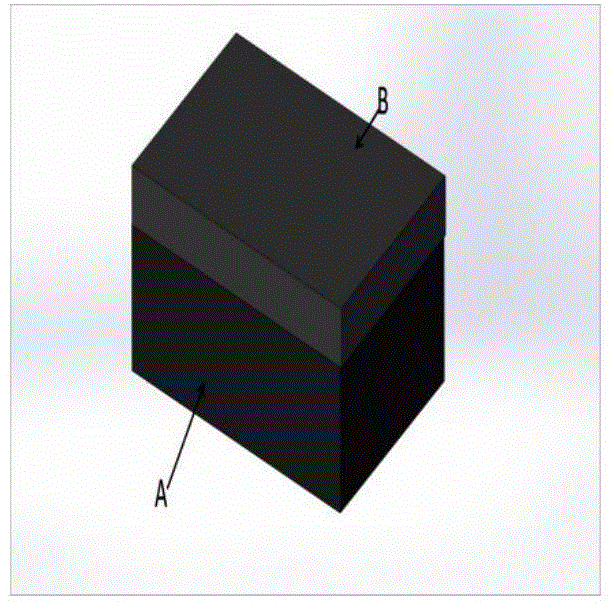Preparation method of double-layer self-supporting magneto-electric composite thin film based on barium titanate and cobalt ferrite
A technology of magnetoelectric compounding and thin film preparation, applied in the field of microelectronics, can solve problems such as leakage, affecting magnetoelectric coupling, etc., and achieve the effect of preventing rupture
- Summary
- Abstract
- Description
- Claims
- Application Information
AI Technical Summary
Problems solved by technology
Method used
Image
Examples
Embodiment 1
[0034] Example 1: Prepare a magnetoelectric composite thin film of cobalt ferrite and 10 nm of barium titanate with a thickness of 20 nm.
[0035] Step 1, growing a magnesium oxide film on a C-plane sapphire substrate.
[0036] 1.1) Put the sapphire substrate, magnesium oxide target, barium titanate target and cobalt ferrite target on the C side into the reaction chamber of the pulsed laser deposition system, and vacuum the reaction chamber until the vacuum degree reaches 4*10 -6 Below mbar, then feed oxygen into the reaction chamber to maintain the oxygen pressure in the reaction chamber at 5*10 -3 mbar;
[0037] 1.2) Turn on the laser switch and set the energy density of the laser to 4J / cm 2 The sum frequency is 3Hz, the temperature of the substrate is set to 600°C, and the magnesium oxide target is burnt 10,000 times through the laser beam, so that the burnt magnesium oxide plasma is deposited on the sapphire substrate on the C surface, and the magnesium oxide thin film i...
Embodiment 2
[0051] Example 2: Prepare a magnetoelectric composite film with a thickness of 30 nm of cobalt ferrite and 15 nm of barium titanate.
[0052] In the first step, a magnesium oxide film is grown on a C-plane sapphire substrate.
[0053] 1a) Put the sapphire substrate, magnesium oxide target, barium titanate target and cobalt ferrite target on the C side into the reaction chamber of the pulsed laser deposition system, and vacuum the reaction chamber until the vacuum degree reaches 4*10 -6 Below mbar, then feed oxygen into the reaction chamber to keep the oxygen pressure in the reaction chamber at 0.01mbar;
[0054] 1b) Turn on the laser switch and set the energy density of the laser to 4J / cm 2 The sum frequency is 4Hz, the temperature of the substrate is set at 650°C, and the magnesium oxide target is burned 13,000 times by the laser beam, so that the burnt magnesium oxide plasma is deposited on the sapphire substrate of the C surface, and the magnesium oxide thin film is comple...
Embodiment 3
[0068] Example 3: Prepare a magnetoelectric composite thin film of cobalt ferrite and 20 nm of barium titanate with a thickness of 40 nm.
[0069] Step 1, growing a magnesium oxide film on a C-plane sapphire substrate.
[0070] Put the sapphire substrate, magnesium oxide target, barium titanate target and cobalt ferrite target on the C side into the reaction chamber of the pulsed laser deposition system, and vacuum the reaction chamber until the vacuum degree reaches 4*10 -6 Below mbar, feed oxygen into the reaction chamber to keep the oxygen pressure in the reaction chamber at 0.1mbar; then turn on the laser switch and set the energy density of the laser to 4J / cm 2 The sum frequency is 5Hz, the temperature of the substrate is set to 700°C, and the magnesium oxide target is burnt 15,000 times by the laser beam, so that the burnt magnesium oxide plasma is deposited on the sapphire substrate of the C surface, and the magnesium oxide thin film is completed. grow like figure 2 ...
PUM
| Property | Measurement | Unit |
|---|---|---|
| thickness | aaaaa | aaaaa |
| thickness | aaaaa | aaaaa |
| thickness | aaaaa | aaaaa |
Abstract
Description
Claims
Application Information
 Login to View More
Login to View More - R&D Engineer
- R&D Manager
- IP Professional
- Industry Leading Data Capabilities
- Powerful AI technology
- Patent DNA Extraction
Browse by: Latest US Patents, China's latest patents, Technical Efficacy Thesaurus, Application Domain, Technology Topic, Popular Technical Reports.
© 2024 PatSnap. All rights reserved.Legal|Privacy policy|Modern Slavery Act Transparency Statement|Sitemap|About US| Contact US: help@patsnap.com










